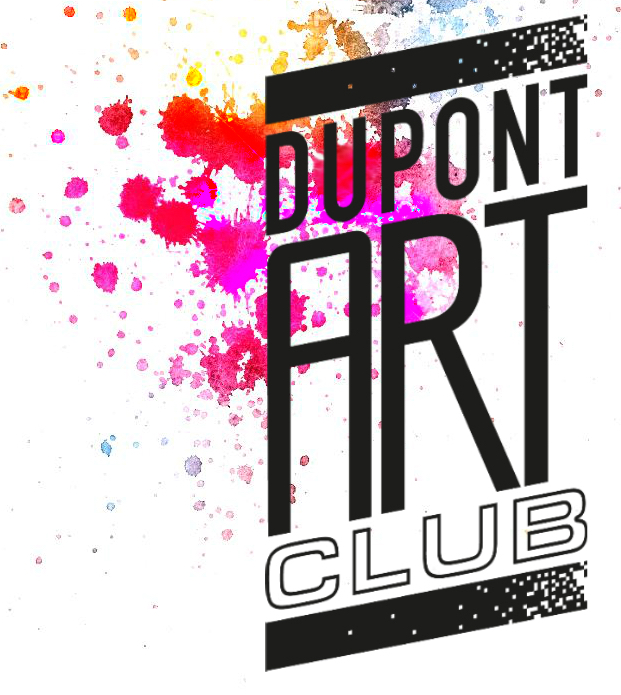News and Articles
Read about upcoming exhibitions and see art demonstrations and art tutorials from Dupont Art Club.
Painting Snow
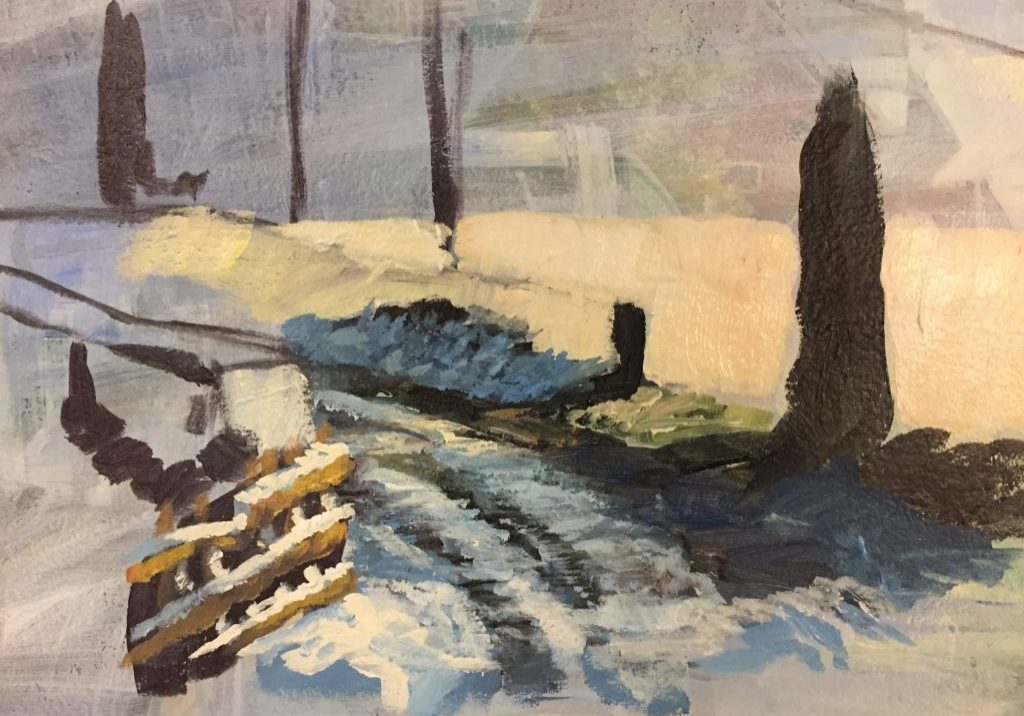
Dupont instructor, Caroline Marsland gave a demo on painting snow on Dec 13/17. She used acrylic paint mixed in big batches of colours and started with a quick sketch. She informed us that snow was painted cool the foreground and warmer in the background. It works dark to light. Very often tracks in the snow lead your eye into the picture. Snow reflects all the colours around it. Watch out using grey as it kills the picture. Colour makes snow look bright, especially cad orange , yellows and pinks. Cobalt blue gives a clean look. Different whites can be used for buildings. Build up your painting and check tonal values.
Painting Rust Demo 15th November

The title of this week’s demonstration may not sound that exciting, but Caroline presented a very interesting session, bringing a rather ordinary subject to life with innovative techniques. There were three images of different forms of rust, each requiring different treatment, as sectioned below: Mosaic Rust Acrylic Mixing Cadmium Red and Cadmium Yellow deep making a rust colour, paint on a few shapes in purple, then fill in with a darker red and high light with orange/yellow. You can use a damaged brush .For the flakes mix white with blue for three shades of grey. Gradually build the flakes, using the three greys and inserting dark shadows, as below Dripping Rust Watercolour Using a flat brush, put on a water wash. Mix Yellow Ochre & Orange and allow it to drip down. Then add the red and allow it to move around with the flat brush. Add the dark brown on top and, while still wet, sprinkle with sea salt. Rust Columns Watercolour Put a water wash on first, using a blue grey. Wash in between grey infills using a yellow layer. Put orange onto the yellow and allow to drop. Splatter with dark red/brown. We were all engrossed and found the demonstration really riveting!
Painting Fur & Feathers Demo 1st November
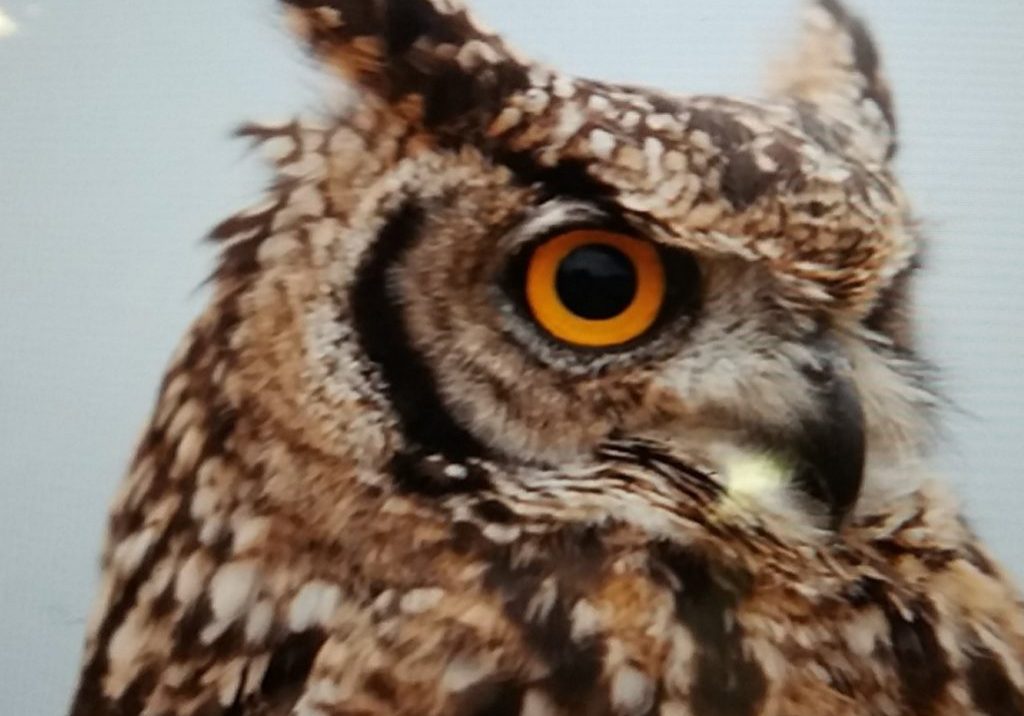
This demonstration was most helpful for those of us wanting to paint animals and birds. Caroline started by introducing us to painting short feathers, as those on the owl below: Mix three shades: dark, medium and light of the colours of the feathers. Start with the dark shapes , loosely and with little strokes. Use the medium brown and build up layers, putting on blocks of colour. Use the white of the paper for the lightest part of the feathers Put in the lighter shades, pulling in colours using the side of a flat brush with little flicks, allowing dark colours underneath to create depth. For longer feathers, as in the tail feathers of the hen draw out the outlines first, then put in the dark areas. Fill in the shadows using the medium shade. When brushing long feathers, start at the quill and work outwards. Fur For fur use dark tones first and follow the direction of the fur. Use a rigger for finer points. Think about the highlights, which go on last Use a dryish “damaged “ * brush with unwatery paint for the wispy fur ends.. Using a mid- grey rather than white, build up the light areas. A useful trick is to use a flat brush with a different colour on each side *Any old flat brush will be suitable. Just snip it irregularly with nail scissors until it is nice and spikey!
Movement in People 4th October
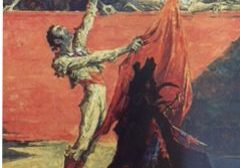
Caroline started her talk by showing some examples of people in motion. Artist Sergei Chepik used strong exaggerated poses to bring energy to his paintings such as the bullfighter. While Mary Cassatt used the strokes of her pastels to convey movement. She painted babies and toddlers who were "caught in the moment " as it is obvious to the viewer that the child could not have maintained that pose for long. To capture people moving can be tricky and it might help to draw a stick figure first, taking care to show the curve of the back, and the correct angles of the arms and legs. The correct slope of the shoulders, waist and hips can be indicated with a straight sloping line. From this base you can then flesh out the drawing. You don't even need to paint fully every part of the body, sometimes it's better to simply give a blur suggesting a hand or foot as this in itself will suggest movement. You should try to measure the angle between the head and the legs to ensure you position them correctly. Once you are happy with the positioning of your figure you can enhance the feeling of movement by putting in creases in the clothing and shadows on the limbs to emphasize muscles being used. Hair is also great to convey movement as it can be shown flying in the wind. Landscapes can be made more interesting by the inclusion of people working, or simply walking. If the figure is shown performing a sport , the brain automatically fills in the next move to your still frame and so movement is seen. Once again, many thanks to Lesley McBride, who kindly provided the text and photos of this session.
Mediums Demo 20th September
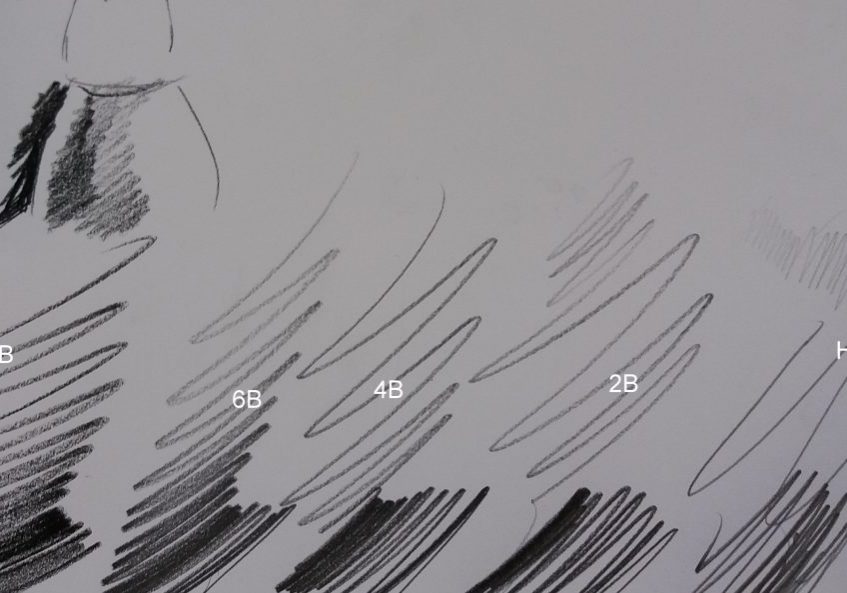
Today Caroline presented a selection of mediums: Pencils, both lead and coloured, charcoal, watercolours, acrylics and pastels, along with her personal recommendations as to brands. Pencils Caroline favours 8B for drawing, as it is possible to get a really dark tone with it. HB she finds too hard and light, but these can be used for watercolour sketch-ins. Recommended brands are Faber Castel and Staedtler. Coloured Pencils The cheaper ones need more pressure. Caroline suggests that we press hard and add layers before adding water and blending. Best quality are Derwent, followed by Faber Castel and Caran d’ache. Charcoal Avoid Coates. There are different sizes in Winsor and Newton’s range. Some is reconstituted. Derwent charcoal pencils are good for fine lines. Can produce a very dark line too. Watercolours The Russian brand – White Knight are very sticky, but have lots of pigment. They are now available from Jackson Art, and can be bought individually. Daler Rowney need a lot of rubbing. A good indicator is that if the paper shows through, the paint is cheap, as with Pelican, which has very feeble colours. Acrylics Golden and Liquitex are the recommended brands as System 3 student quality has some poor colours, particularly the yellows. Winsor & Newton Galleria come under the same banner. Gel mediums can be used with acrylics: mix with acrylic to bulk up paint, but be aware that this will dilute the pigment. Also available are crackle textures. You can make your own gesso with talcum powder +PVA+water. Pastels WH Smith have a good colour range. Schmincke are very soft, for those who like this effect.. Pan pastels can be used with a sponge for smudge work. Sennelier are a favoured make. Faber Castel makes a range of pencil pastels. Caroline said that it is best to...
Painting with Oils 6th September

Painting with Oils 6th September Many materials can be used to paint on: canvas, canvas board, hardboard or paper, but all must be sealed before starting. Those bought ready made from art suppliers are “ready to go” but if you use hardboard or paper, you will need to apply a coat of size or, as Caroline does, a coat of household emulsion. The importance of working fat on lean: Start with thinned layers of paint for under painting and build up to thicker layers with added linseed oil for fluidity. You can choose from a range of oil mediums: linseed oil, poppy seed oil, walnut oil, and safflower oil. The choice of oil imparts a range of properties to the oil paint, such as the amount of yellowing or drying time... Water based oils need their own specific oils, as per the makers’ instructions. Use a thin under-paint consisting of a colour and turpentine, which won’t take too long to dry. You can then add layers of subsequent paint without delaying too long. With over-painting, sometimes if too many layers are applied, it can become muddy and overworked so the options are to scrape off or leave to dry and paint over. Glazing - Building up layers of thin paint. As with the last demonstration on 16th August Glazing on Black & White Acrylics), start with a thin layer of paint + turps which allows the sketch to show through and keep over-painting, adding heavier amounts of colour. You can also use a technique called Impasto – this involves using the paint thickly to show brush or knife marks, Van Gogh painted in this way. Disposal: Oil paints and the thinning mediums are flammable, so soak any rags or paper towel in water before throwing them in the bin. They can...
Glazing on Black and White 16th August
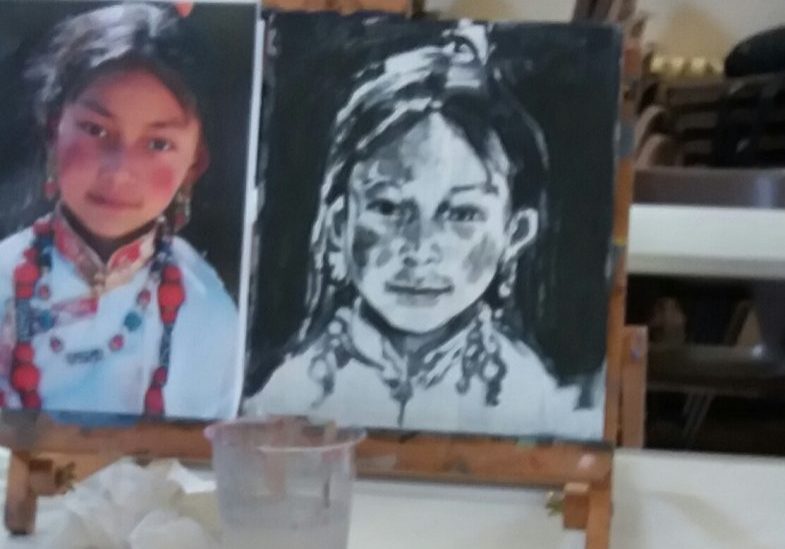
The use of glazes over a black and white portrait painting gives a different glowing result. Caroline had a photograph of a young person and had painted it in black, white and greys to start with. She pointed out that it is vital to get tonal values set first. Working from light to dark, and using either a glaze medium or cheap paints, apply a wash, which allows the dark image to show through. The use of cheaper acrylic paints is suggested because they have less pigment in them therefore a glaze effect is much easier. Using a filbert brush, mix a light flesh tone and add it to the pale area of the face, adding more pigment layer by layer. The filbert brush doesn't give hard edges. This is the result needed with this type of portrait painting. Add pink to the image, bringing in the warmth. At this stage you can go back and forth between the dark and light areas. Working wet in wet blends better, which means you can mix colours on the page if you want to. Use solid paint for definition, and block in with white if you make a mistake, then start again as it is very easy to go dark in portraits. Palate: Cadmium Red, Yellow Ochre, Cobalt Blue, Burnt Sienna, Hookers Green, Cadmium Red medium. It was agreed that this was a really helpful session for those of us that aspire to portrait painting, as this technique allows a very gradual build of a work instead of the dramatic and sometimes disappointing results of using solid paint from the outset. The use of glazes results in a real glow in the work which can't be achieved with the use of direct non layered painting.
Preparing Work for an Exhibition
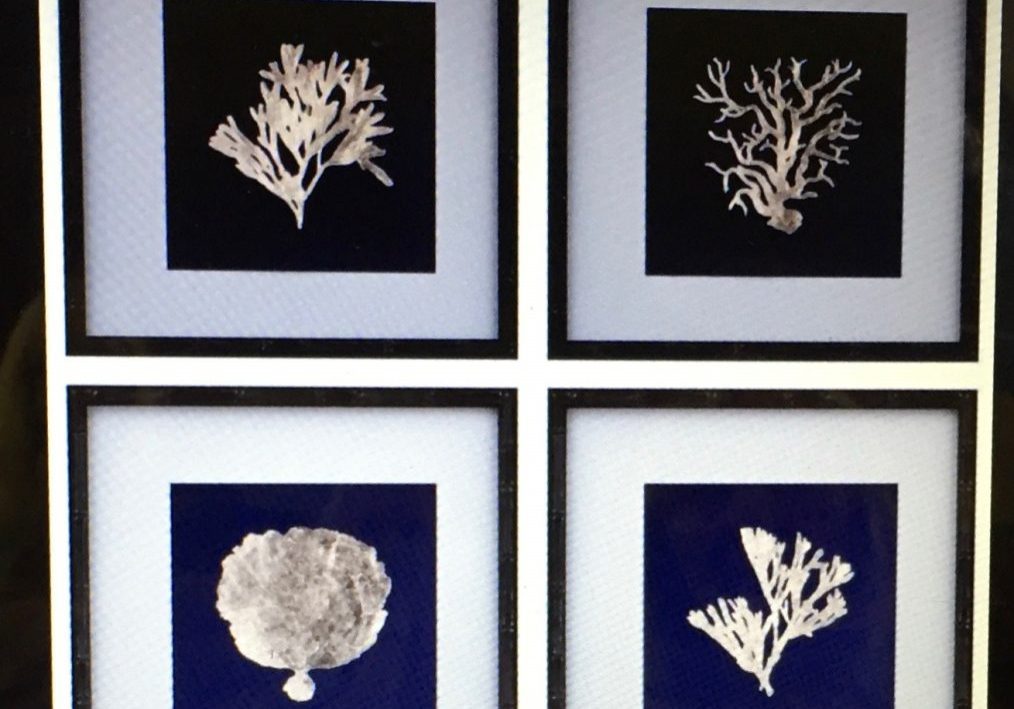
Thanks go to Lesley McBride, who recorded Caroline’s talk, and to Judy Alexander for the images. Caroline Marsland’s talk today was especially helpful, with the Club’s upcoming exhibition in August now only weeks away. Some valuable advice about choice of frames and examples of different effects will be valuable to those who are putting work forward shortly. Choosing a Frame It is always best to go simple. For example, a busy picture does not want to compete with a very ornate frame, but using a large white mount can offset this. The frame should hold the picture together. Maybe use a lesser colour from the picture in the frame. Natural wood frames are not in vogue at present, and heavy dark frames are also out of favour. Using mounts can help to draw the eye into a smaller picture, or a larger, thicker frame can add drama to a small picture Framing Try car boot sales for old frames, where you can fine old frames very cheaply. You can rub them down before painting or varnishing, (chalk paint is available in Aldi for £4.95 per tin and comes in antique white and grey). Also try second hand shops or charity shops . Ikea do good frames at reasonable prices, as do B&Q, Dunelm, Asda @ Hollingbury and The Range in Worthing. Use architraving if you have a mitre saw. Unusual frames can be made using driftwood, twigs, or an old clock face. Craft frames can be made using any old stuff glued to the frame, then sprayed to unify it. Box frames always look good. Backing Use D-rings or eye hooks. D-rings are on Amazon for a bag of 100 (£5-£6). String can also be found at car boots or on-line. You must use strong string or wire with...
Plein Air Painting 19th July
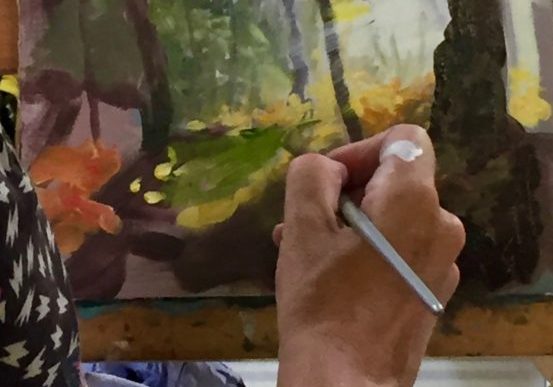
Caroline began her demonstration with some points to consider before starting an open air painting session. Reconnoitre before choosing a site. Are there a lot of possibly intrusive people around? Consider the weight of your equipment. A half-size easel will ease the load, as you may have to climb for a better vantage point Do some thumbnails to help decide on your composition If using acrylic paints, remember that they will dry more quickly outside. Use a stay-wet palate Once you are settled and starting to paint, lay down light tones and darks at the outset, bearing in mind the changing light as time passes. Get your tonal values down at the beginning. She suggested working with big brushes to do this, to avoid “fiddling”. Outdoor painting needs you to make light colours lighter and darks darker, which will compensate for indoor light levels. Method: Working from the back to the front of the scene in light tones…look-paint, look-paint. To achieve shafts of light, use a glaze at the end of the work. Focus on lights and darks is most important. As an example, your composition should be 70% cold and 30% warm colours or vice versa. Keep a varied selection of greens and add a few browns to your palate for woodland scenes. Use a rigger for the small upper branches, which can be added later, along with foliage. Lastly – Be rougher and have fun with it!!
Lino Cutting Demo

Caroline Marsland, our tutor gave a demonstration of lino cutting at our July wednesday class. I have taken the liberty of copying the description of lino cutting from 'Gradually Greener in Print making' from the web site. Carolines comments and instructions are added at the end. "What is a Linocut?: Linocuts are very similar to woodcuts. It is a printing method using a sheet of linoleum, in which a subtractive cutting method is used to take away the parts of linoleum where you want to leave the white of the page, and keep the parts you want to be inked! In the result you have a linocut that can reproduce the same image over and over again. A Short History: While linoleum was first invented in the 1860s, it wasn't used as a medium for printing until the early 1900s in Germany, where it was first used for making patterns on wallpaper! Artists ranging from Pablo Picasso to Henri Matisse have made linocuts, and today it is considered a respected art form. Linocuts are also very popular in teaching children in schools about the rewarding art of printmaking. Why linocuts?: First off, linoleum does not have a grain like wood does, meaning there is no need to cut in one direction. Also, it is much, MUCH easier to cut than wood, especially when heated. Although linoleum is not quite as durable as wood, you can still make hundreds if not thousands of copies of the same image with a single linocut before it is too degraded to use. Linocuts generally remind me of illustrated children books, which is a style I very much like. One can even make several linocuts to be used together to make a print including color, and in some cases (depending on the ink and paper you use)...
Bauhaus Furniture 21st June
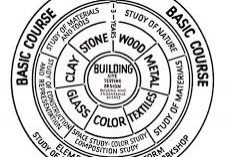
The Bauhaus (trans. School of Building) was founded in Weimar in 1919 by Walter Gropius, who was very interested in manufacturing combined with art. It was created as a centre for all arts. The Arts & Crafts movement was a big influence, as, under William Morris, it espoused the idea of functionality and beauty. After a while the medieval forms were thrown out and a more stripped down model favoured. The school had pottery departments, furniture workshops and produced posters in the art department. After a while, metal became favoured over wood and the material for chairs and tables. Famous artists such as Kandinsky and Paul Klee taught there, and many others aspired to join the teaching staff, such was the growing reputation. Below is a diagram of the comprehensive course offered after the move to Dessau. There was a strong influence from Mondrian’s works, which is apparent in the building at Dessau, and the modernist architecture of the building set a style for many buildings. In 1932 the school moved to Berlin, where, under political pressure, it was closed by its leadership in 1933. Caroline showed us many images of the furniture produced by the school, which cannot appear here, due to copyright constraints, but for those interested, the internet has many images on Google Images under Bauhaus furniture. Some will seem familiar, as indeed they are. The influence is very strong in today’s market place with the growing taste for modernist style in the home. The talk was very interesting, particularly as we are surrounded by furniture and design whose origins are in the Bauhaus. Ikea, although a Swedish company with the Karl & Karin Larsson historical connection, has many pieces reflective of this famous German school.
Composition Demo 7th June

We were treated to a very comprehensive and helpful talk and demonstration on composition by Caroline, in which she outlined how to plan a picture, illustrated by examples by well-known artists from different schools. There followed two examples of assembling a painting, during which the choices and various techniques that can be used were demonstrated. Before starting a composition there are several points to consider: Contents What is important Point of interest How to use colour Tonal values The Rule of Three (Golden Section) Some artists put the focal point in the centre, while others use a triangle, commonly seen in religious works, with people scattered around. Abstractors often use a cruciform and sometimes the S shape. In the first picture – The Lady of Shalott by John William Waterhouse, she is central and the brightest, most detailed in the image. The dress is bright white and the belt a contrasting black. The line of the land runs parallel to her chin. The second picture was a triangular placing, with no bright colours at the edge to keep the eyes inside the page. All lines point to the face. Isabella, by Holman Hunt is the third picture. Once again everything points to the face and there is little emphasis on any background. Ben Nicholson in picture 4 used constructionism. He liked everything to be within a “frame. All the colours work together and “speak” to each other. All the lines are broken, so that the eyes don’t go off the page. He uses squares and rectangles. The placing on the page could be seen as related to Isabella, above. Picture 5 is by Karl Larsen, where there are many downward lines. Everything goes down to the table and stops the eye there. The woman in black is the...
POP Art
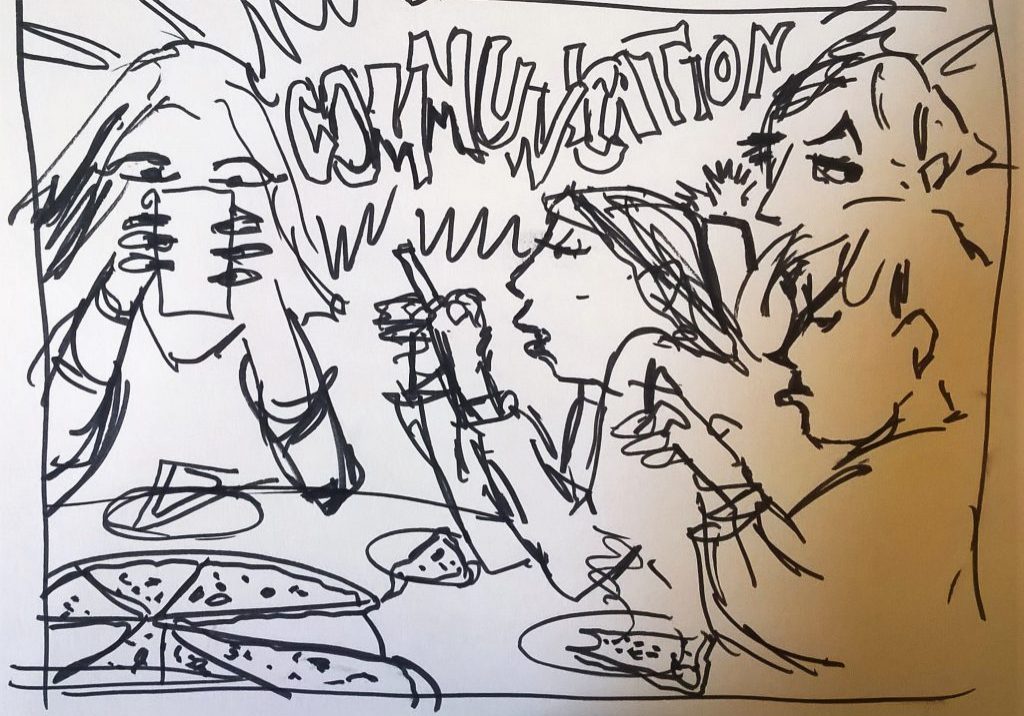
On the 24th May Caroline gave us a talk and demonstration on “Pop Art”. She started by telling us that although we associate pop art with the 50’s and 60’s, it emerged as early as the 1920’s. Artists were reacting against traditional movements typical of the Victorian era as well as the upheaval of WW1. They were looking forward to a brighter future and this was reflected in painting and design. Caroline showed us a jazzy print of a number five that could easily have been designed in the 1960’s but was in fact created about 1920. Pop Art was also associated with Art Deco and the Dada movement. After the Second World War artists again were looking at society anew and taking inspiration from consumer items and were commenting on the roles of men and women. Caroline showed us some more familiar images including Richard Hamilton’s collage of a man flexing his muscles while a woman sits on a sofa, surrounded by modern day trappings. Richard Hamilton was British but most of the artists we are familiar with were from the US, including Oldenberg, Lichtenstein, Rauschenberg and Warhol. Much of their work took a wry look at the superficiality of American life. Lichtenstein was inspired by cartoons and magazine images to make his paintings, such as a woman’s manicured fingers using a spray can or a high heeled shoe stepping on a pedal bin. He was also keen on using images of glamorous couples in sports cars, or macho pilots in planes with comments floating in speech bubbles. Caroline took her inspiration from Lichtenstein’s cartoon paintings to demonstrate an idea for a take on contemporary life. Using a felt tip she drew a typical family out to lunch at a fast food restaurant, all of them glued to their...
Watercolour Demo by Polly Raynes 10th May
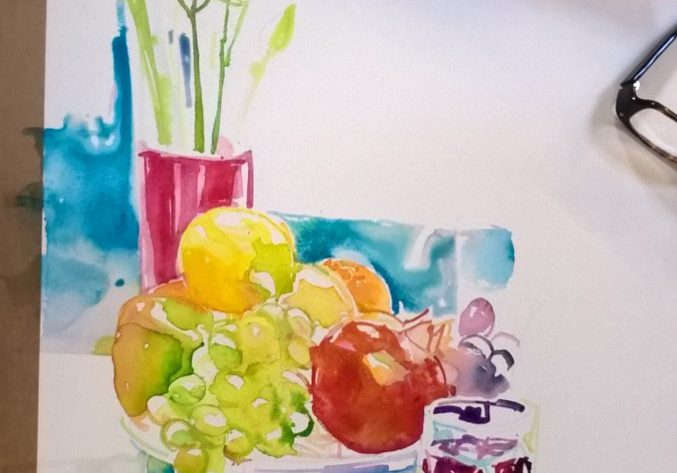
We were very fortunate to have Polly Raynes demonstrate her methods of using watercolours for the club. After drawing an outline of a most attractive still life, Polly began by saying that sometimes we need to put space between ourselves and the image. Also, not to worry too much about colours running. Just keep an eye on the highlights, then lay in tones. Let the water do its own thing. Use soft but primary colours. Work on one area and then move to a different space to allow the first part to settle. Glass is much more sparkly using just highlights. Use a rigger (No. 4) to “draw” lines. Where the background is concerned, it’s not necessary to fill in all detail, just suggestions . White paper left blank can highlight the form of the picture. Materials: Polly uses QOR tube paints, as she finds the colours stay fresh and don’t become muddy like the blocks tend to. Paper: Bockingford standard does not soak up all the paint, and allows for mixing and dribbles etc. Brown: Invest in brighter colours which produce vibrant tones, rather than pre-mixed burnt umber etc. Polly mixes purple + turquoise + warm yellow to make her browns.
The Importance of Good Design

Yesterday I had the pleasure of stewarding at the Scottish Diaspora Tapestry being exhibited at the Westminster Hall in London. This spectacular collection of embroidered panels from people of global Scottish descent was amazing in it's blending of colours, line, and design. Many people commented on the use of similar colours and drawing style. This was because all of the 305 panels were carefully designed by one artist. This talented artist was Andrew Crummy. He drew each panel with lines and colour and left the actual stitching styles and some content to the embroiderers. This gave this display the continuity needed for such a grand effect. This continuity of good design and style is important for an artist to develop ones own reconizable artistic voice. Investigating many ways of doing art is all part of the growing process for an artist. Settling on one subject or method can be a challenge. The backbone of artistic progress must be in good design. After that, following your passion is what inspires you to produce more. Thoughts from a Dupont Art Club member J. Alexander
When is a Painting Finished? 12th April
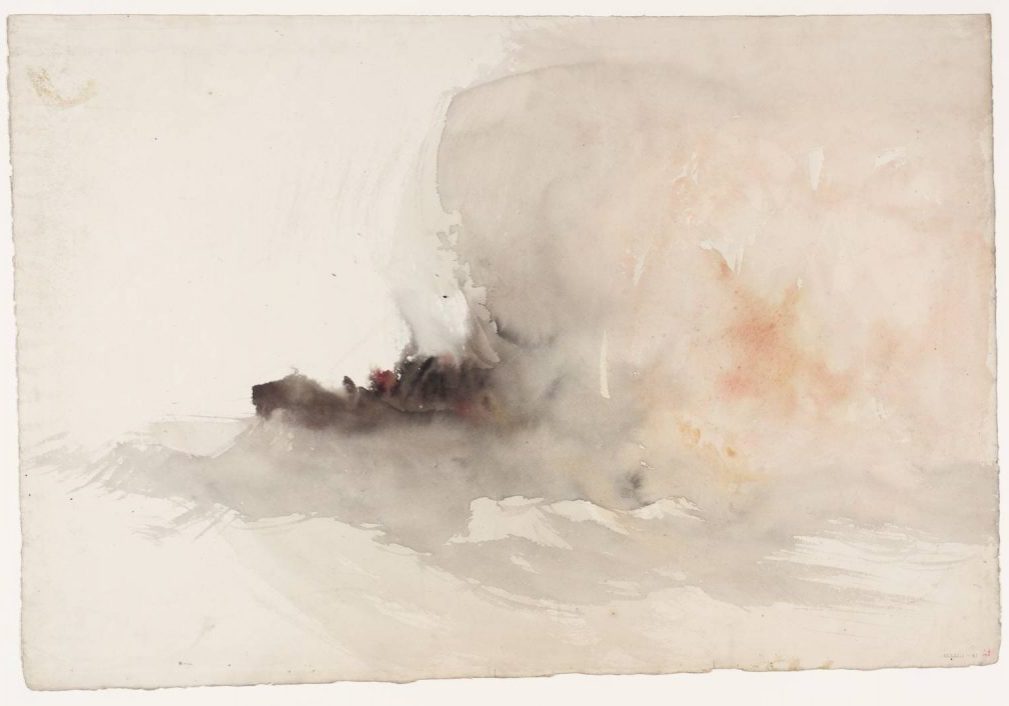
A talk by Caroline Marsland. There is no limit time-wise to finishing a painting. The examples by Turner of a ship emerging from fog and a train emerging from steam capture the mood effectively yet have little detail. Turner stopped painting as soon as the work said all he wanted it to say. Several paintings may at first glance look “unfinished” but they concentrate on the focus which could be a face or even a mood, feeling or tone. The Lowry concentrates on the stairs of a footbridge and there is no extraneous detail. Paintings can be overworked. The beach scene by Eric Fischl has every figure done with the same degree of detail and confuses the eye. When working on your own painting consider: Are the colours balanced? Is the focal point correctly positioned? Are there any distracting objects? Does the eye flow round the painting? Does the painting convey the message you want? To assess your work, it may help to stand farther away, look at it through a mirror or even put it away for a few days then re-examine it with fresh eyes. Many thanks to Lesley McBride, who kindly took notes and photos in my absence.
Perspective Demo 15th March

Caroline gave a very interesting demonstration of the use of perspective last week. There was a detailed and fast commentary to accompany the diagrams, and for that reason, this report has only shots of the demo. Caroline has asked that, in the interests of clarity, anyone who would like to have any further explanation should speak to her. We all enjoyed the session very much, and watched in awe as Caroline deftly produced what seemed like architectural drawings at great speed. One Point Perspective was very useful for those of us attempting the terraced houses of Brighton/Anywhere, and Two Point Perspective no less so. The planning of stairs was particularly helpful too. With regard to still life drawing of vessels, the planning of an ellipse and cup showed method as opposed to freehand.
Life Drawing Domonstration
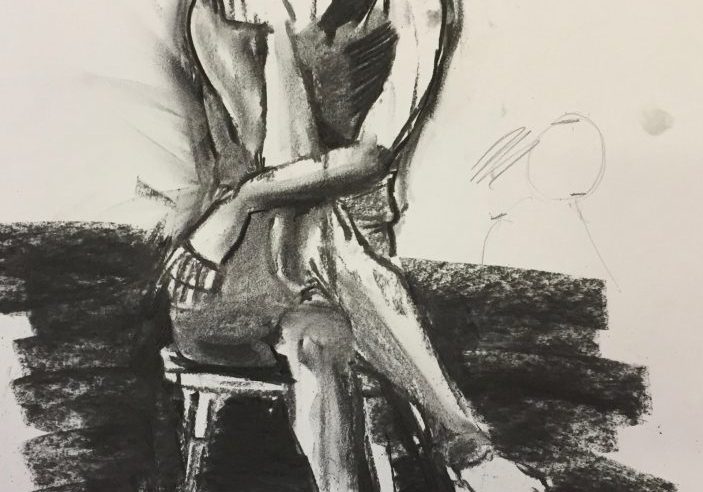
Life Drawing On March 1st Dupont art instructor, Caroline Marsland gave us a lecture and demonstration on life drawing. She started out by advising us that we need to decide at the beginning what we want to say in the picture. We can be accurate, want to accentuate certain features, show certain emotions, etc. She recommends that we do several quick sketches first before doing a large drawing. Look at the general shape of the figure. Don’t start with the head. Draw the shape of the back, the shoulder placements along with the hips, and legs. See if you can see shapes in the body. identify points on the body to line them up accurately, look at angles of these shapes. Perspective is important with accurate drawing. A child’s body if approximately five times the size of it’s head while a man’s is seven times the size of the head. There are three heads size to the waist and hands fall to the thighs. For head measurement, from the palm of your hand to your finger tips are usually the measurement from the chin to just above the eyebrow. Look at negative shapes to assist with accuracy. Build up shadows for shape. Squint for these shadows. Always step back from your drawing to judge the accuracy. In order to judge the size, hold your pencil out with a straight arm against the part of the distant body you are drawing and compare it to other parts. Use any paper which has tooth to it. Charcoal and chalk are dramatic and charcoal and watercolour work well together. She warned us that some of the charcoal sticks available now are quite scratchy. She recommends the Windsor and newton ones give a smooth finish. This workshop is a precursor to an all day...
Portraits in Watercolour 15th February

In discussing the differences between painting young and old faces, Caroline began with a very helpful hint: use wet in wet for young smooth faces, wash over first and drop in the colour, giving the bloom on the cheeks. The model this week was a Cuban woman of some years, accompanied by her cigar. Starting by penciling in the features, beginning at the nose, Caroline then outlined the mouth and lastly the eyes. To paint this very colourful subject, the following palette was used: Firstly she used a weak yellow wash generally. Yellow Ochre was the base colour, mixed with red & green. For the brown, Caroline always mixes her own with red and green. For the wrinkles she mixed Cadmium Deep Red with Ultramarine and Yellow Ochre was made and orange for the eye sockets. For the olive green of the cheek patch and background, Hookers Green, Claret or Cherry red were used and a purple used for the lips. We all watched with awe as the aged face emerged under Caroline’s deft brushwork. The following pictures give an idea of the gradual building of the portrait.
Mixed Media Demonstration
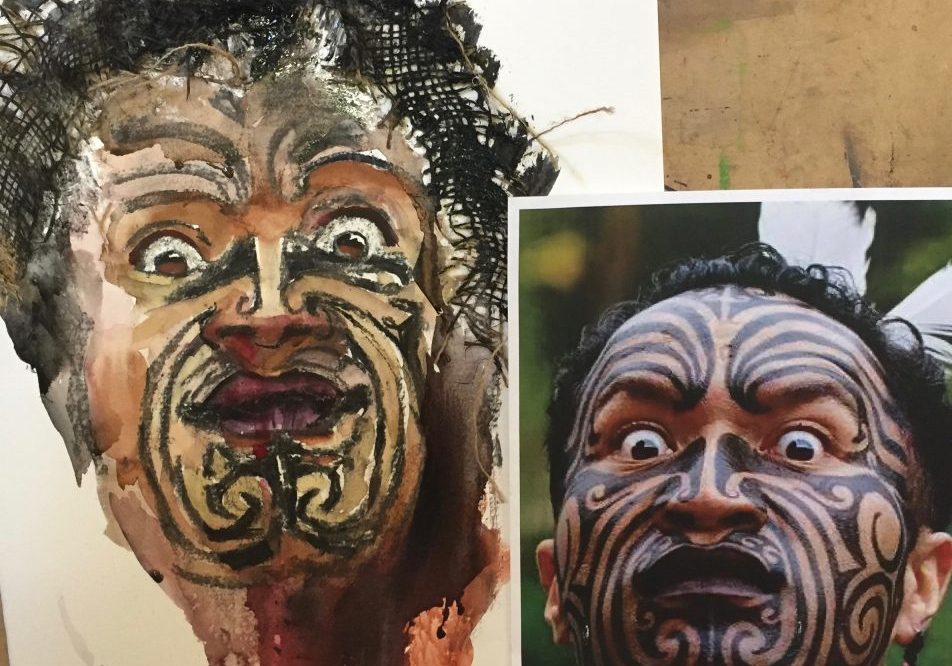
Caroline Marsland demonstrated the use of mixed media to the Dupont Art Club class on January 18th, 2017 It is important to chose the media to match the painting. Layering is the key to mixed media. She pointed out that almost anything can be used in a this type of painting. Suggestions for the first layer could be regular or water colour paper which could be painted, layered in tissue which is glued on, or use of old maps, newspapers, fabric, canvas, wood, metals, old books, etc. Layered materials which can be used are all types of paints, inks, pens, pencils, charcoal, pastels, chalks, waxes, as well as fabrics, pieces of wood, leaves, wire, modelling paste used with stencils, etc. In her demonstration, she chose a photo of a Maori painted face which she drew and layered with stick charcoal using a child's birthday wax candle to highlight the eyes and added water colour to the face. She glued on hessian for the hair and painted it black. She encouraged everyone to search online for demos using mixed media to find new ideas and other sources of inspiration.
Painting a glass bottle 7th December

In this very interesting demonstration, Caroline started with a pale green wash, onto which she loosely sketched the shape of the straight sided bottle. Then she put in a white background around the shape. Using a flat brush she painted in the four corners and the base of the bottle, then the round neck. A lighter tone of the green base colour filled in the body. Caroline said that the complex and numerous shapes and reflections could not all be recorded, so we should select some shapes that appealed. A green bag and red bauble that were behind the bottle were incorporated. Keep the highlights until last and use a rigger and white paint. When painting round bottles, make sure the ellipses match. Caroline finished with some shadows thrown around the base of the bottle.
Book Jacket Talk – 12th October
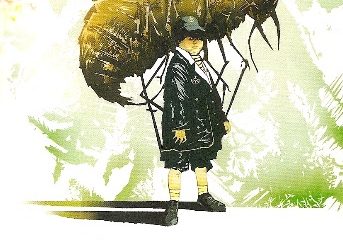
My thanks to Lesley McBride for again supplying notes and images for this talk. Caroline began by discussing the ways in which book covers are designed nowadays. Everyone uses a computer, employing either GIMP or Photoshop, which are both compatible with Mac and PCs , but GIMP is free. The work is done in layers: The first layer may be the author's name The second layer the title of the book The third layer the image you have chosen Caroline gave a quick demonstration using one of her still life images, and showed us how to manipulate the image to fit, and also how to change the background colour, font styles and colours to obtain the most effective result. You would go about choosing your image based upon what the book was about, e.g. historical, modern, spy, murder mystery, sci-fi, romance etc... Remember the design needs to stand out on the bookshelf. To this end it is useful to employ red either in the image or the lettering as the eye is always drawn to red. Similarly a nude is likely to draw attention. She discussed several book jackets that were used for Lord of the Flies, some of them being much more effective than others. We all agreed that the one showing the silhouette of the young boy in white and the flies in red invading his brain was the most compelling. You may prefer another one, as it is a subjective thing. I have included copies of some of the jackets for your perusal. It should be borne in mind that the image should not make the lettering hard to decipher, they should complement each other, and the lettering should not be so stylized that it is confusing.
Watercolour Textures Demo 28th September

Caroline introduced a number of ways to produce washes, using both a paintbrush and other materials to get varied effects. The first was with an upright board and brush: Wet on dry Wet on wet Graded Wet on dry: using a flat 1” brush and dark paint, not too water brush once across and drag down for a drop down effect Wet in wet: using very clean water and wet paper, soak in for a minute. Paint across quickly…don’t over-work, then paint across. Graded: Start with a sideways sweep and use less colour for a graded effect. Clouds can be inserted by using a balled tissue to remove the paint. Note: Kurt Jackson used watery paint and turned the board sideways to dribble and splatters too! Flat work using materials for application Cling film: using strong colours, apply cling film and ruche it. Leave to dry before removing for a foliage effect. Can also be used for rocks, using dark brown, green and wet in wet red. Washing-up liquid: can be used for waves by squirting into applied wet paint. Dry brushing: on very dry paint, drag a dry brush across. Fan brush: use to produce a wood grain effect Oil pastels: use colour free pastels and make marks, then brush over with a wash of colour. Salt: put on a wash, and quickly sprinkle on salt. Leave until fully dry before brushing off the salt. Good for a rain effect or snow on a dark ground. Scratching: Apply the wash then then scratch with scissors to make trees. Scratch downwards so paint goes into runnels.
Abstract Still Life Demo14th September
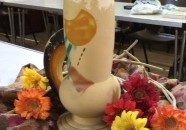
Many thanks to Lesley McBride, who kindly provided the photos and commentary for this demo. The still life Carolyn selected to work from was this: Artists often pick out one aspect of the still life. Difficult to know where to start? Consider: Look at line Look at colours: are they warm or cool? Colours talk to each other with often magical results. Try using a colour wheel to see how each colour affects another. Look at light/shadow/shapes. Remember you can also use the negative spaces. Cubists use shapes as their main focus. Always make sure you have a focal point. You may choose to be either objective using the colours and shapes of the object in front of you, or you could be non-objective and express your feelings about the object without actually painting any physical aspects of the object itself. You should think about colour, tone, light value and composition Carolyn started by establishing her focal point, which in this case were the flowers. She wanted the focal point to be vibrant and lively with the base more subdued. She decided to use the jug handle opting for black as this leads the eye up to the focal point. (Use black sparingly.) She put some folds of fabric into the base using subdued colours which complemented the rest of the painting. Red was used in the base to lead your eye around the painting. This is the finished work, completed in less than 30 minutes.
Sorry, we couldn't find any posts. Please try a different search.
